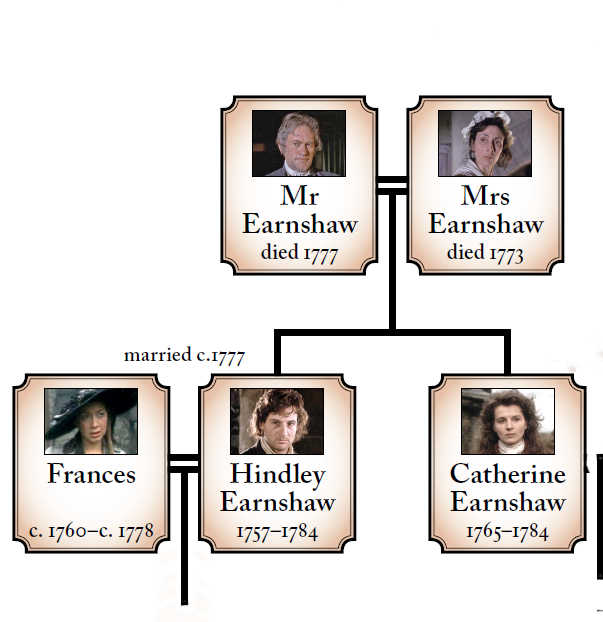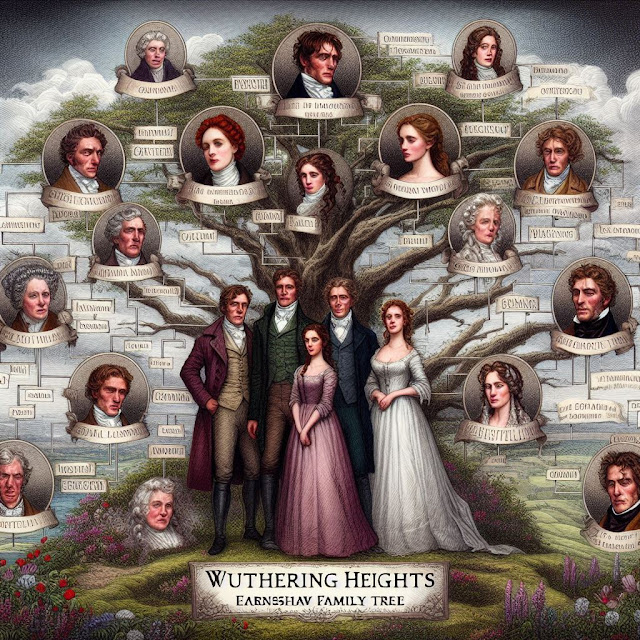Mr. Earnshaw is a central character in Emily Brontë's novel, "Wuthering Heights." As the patriarch of the Earnshaw family, he plays a significant role in shaping the events of the story. Here is a detailed overview of Mr. Earnshaw, including his relationships, children, marriage, and ancestral background.
Family Relations:
Mr. Earnshaw is the husband of Mrs. Earnshaw and the father of two children, Hindley and Catherine Earnshaw. He is also the adoptive father of Heathcliff, an orphan boy whom he brings into the family from Liverpool. Mr. Earnshaw's decision to adopt Heathcliff sets off a chain of events that drive much of the narrative's conflict and drama.
Childhood:
While details about Mr. Earnshaw's own childhood are not explicitly provided in the novel, it can be inferred that he grew up in the Yorkshire moors, likely in or around Wuthering Heights. His upbringing in this rugged and isolated environment may have influenced his character and values.
Marriage:
Mr. Earnshaw is married to Mrs. Earnshaw, although the details of their relationship are not extensively explored in the novel. Mrs. Earnshaw's presence is minimal in the narrative, and her death occurs early in the story, leaving Mr. Earnshaw to navigate the challenges of parenthood alone.
Family:
Aside from his own immediate family, Mr. Earnshaw is also connected to other members of the Earnshaw family, including his ancestors and distant relatives. The Earnshaws have a long history in the Yorkshire moors, with Wuthering Heights serving as their ancestral home. This connection to the land and its history adds depth to Mr. Earnshaw's character and underscores the themes of heritage and tradition in the novel.
Ancestry:
While specific details about Mr. Earnshaw's ancestors are not provided in the novel, it is implied that the Earnshaws have lived in the Yorkshire moors for generations. Their roots run deep in the rugged landscape, and their presence in the area is intertwined with its history and folklore. This sense of ancestral heritage adds a layer of richness to the novel's setting and underscores the characters' connection to the land.
To Summarize
Mr. Earnshaw is a complex character whose relationships, children, marriage, and ancestral background shape his role in "Wuthering Heights." As the patriarch of the Earnshaw family, he embodies the rugged spirit of the Yorkshire moors while navigating the tumultuous events that unfold within his household.
Mrs. Earnshaw: The Family Mother
Mrs. Earnshaw, though not as prominently featured in Emily Brontë's "Wuthering Heights" as some other characters, still holds significance within the narrative. Here's a detailed overview of Mrs. Earnshaw, including her family relations, ancestral background, and childhood:
Family Relations:
Mrs. Earnshaw is the wife of Mr. Earnshaw, making her the matriarch of the Earnshaw family. Together, they have two children: Hindley and Catherine Earnshaw. Additionally, Mrs. Earnshaw becomes the mother figure to Heathcliff after her husband brings the orphan boy into their home from Liverpool.
Ancestry:
While specific details about Mrs. Earnshaw's ancestry are not provided in the novel, it can be inferred that she, like her husband, comes from a long line of Yorkshire moors inhabitants. The Earnshaw family has deep roots in the area, with Wuthering Heights serving as their ancestral home for generations. This connection to the land and its history likely influences Mrs. Earnshaw's character and values.
Childhood:
The novel does not delve deeply into Mrs. Earnshaw's childhood or upbringing. However, it can be assumed that she, like her husband, grew up in the Yorkshire moors, possibly within a family similar in stature to the Earnshaws. Her experiences and upbringing may have shaped her character and prepared her for the challenges of marriage and motherhood.3
To Summarize
Mrs. Earnshaw is a character whose family relations, ancestral background, and early death contribute to the complexities of "Wuthering Heights." Though not as extensively explored as other characters, her presence lingers throughout the narrative, shaping the actions and motivations of those around her.
Hindley and Catherine Earnshaw: Family Duo
Hindley and Catherine Earnshaw are central characters in Emily Brontë's "Wuthering Heights," each playing a significant role in the unfolding drama of the novel. Here's a detailed overview of Hindley and Catherine Earnshaw, including their family relations, ancestral background, childhood, and relationship:
Family Relations:
Hindley and Catherine are the children of Mr. and Mrs. Earnshaw, making them siblings. They grow up together at Wuthering Heights, their family's ancestral home on the Yorkshire moors. Additionally, Heathcliff becomes a part of their family when Mr. Earnshaw adopts him, adding complexity to their relationships.
Ancestral Background:
The Earnshaws have deep roots in the Yorkshire moors, with Wuthering Heights serving as their ancestral home for generations. While specific details about their ancestors are not provided in the novel, their connection to the land and its history influences their identities and behaviors. The rugged landscape and isolation of Wuthering Heights shape their upbringing and worldview.
Childhood:
Hindley and Catherine's childhood at Wuthering Heights is marked by both affection and conflict. They experience the wildness of the moors and the harshness of their surroundings, which molds their characters in different ways. Hindley, as the elder sibling, initially enjoys a position of privilege and authority, but his relationship with Heathcliff sours over time, leading to resentment and animosity. Catherine, on the other hand, forms a deep bond with Heathcliff, which transcends social boundaries and class distinctions.
Family Relationship:
Hindley and Catherine's relationship is complex and fraught with tension. Despite being siblings, they are often at odds with each other, particularly as they mature and their personalities diverge. Hindley's jealousy and desire for power create friction within the family, while Catherine's free-spirited nature clashes with societal expectations. Their relationship is further complicated by Catherine's love for Heathcliff, which intensifies as they grow older.
To Summarize:
Hindley and Catherine Earnshaw are integral to the intricate tapestry of "Wuthering Heights." Their family relations, ancestral background, childhood experiences, and complex relationship dynamics contribute to the novel's themes of love, betrayal, and redemption, making them compelling and memorable characters in literary history.
 |
| Wuthering Heights Family Tree |
Frances Earnshaw: A Family Member
Frances Earnshaw is a character in Emily Brontë's "Wuthering Heights," albeit with a relatively minor role compared to some of the other characters. However, she still holds significance within the narrative. Here's a detailed overview of Frances Earnshaw, including her family relations, childhood, and ancestral background:
Family Relations:
Frances Earnshaw is introduced as Hindley Earnshaw's wife in the novel. She becomes a part of the Earnshaw family through her marriage to Hindley, making her the sister-in-law of Catherine Earnshaw and the sister-in-law and adoptive sister-in-law of Heathcliff. While she does not have biological ties to the Earnshaw family, her marriage connects her closely to its members, particularly Hindley.
Childhood:
The novel does not provide explicit details about Frances Earnshaw's childhood or upbringing. However, it can be inferred that she likely grew up in a similar environment to Hindley and Catherine Earnshaw, possibly within the vicinity of Wuthering Heights on the Yorkshire moors. Her experiences and background may have shaped her character and prepared her for her eventual marriage to Hindley.
Ancestral Background:
Frances Earnshaw's ancestral background is not explored in detail in the novel. However, as the wife of Hindley Earnshaw, she becomes a part of the Earnshaw family's lineage, which has deep roots in the Yorkshire moors. Wuthering Heights, the family's ancestral home, holds significance in their history and heritage, contributing to their identity and sense of belonging within the landscape.
Role in the Novel:
Frances Earnshaw's role in the novel is primarily defined by her marriage to Hindley and her interactions with other characters, particularly Heathcliff. Her presence serves to illustrate the dynamics within the Earnshaw family, particularly the strained relationship between Hindley and Heathcliff. Additionally, her character contributes to the overall portrayal of domestic life and relationships within the context of the novel.
To Summarize:
Frances Earnshaw is a character in "Wuthering Heights" whose family relations, childhood, and role within the Earnshaw family add depth to the narrative. While her presence may not be as prominent as some other characters, she nonetheless plays a part in shaping the dynamics and themes explored in Brontë's classic novel.
 |
| Family Tree of wuthering heights |
Heathcliff: A Mysterious Presence
Heathcliff is arguably the most enigmatic and compelling character in Emily Brontë's "Wuthering Heights." His mysterious origins, tumultuous relationships, and vengeful nature make him central to the novel's plot. Here's a detailed overview of Heathcliff, including his family relationships, ancestral background, and childhood:
Family Relationships:
Heathcliff's family relationships are complex and multifaceted. He is introduced into the Earnshaw family as an orphan boy adopted by Mr. Earnshaw. Consequently, he becomes the adoptive brother of Hindley and Catherine Earnshaw. Despite his lack of blood relation, Heathcliff forms deep emotional ties with Catherine, which evolve into a passionate and turbulent love affair. Later in the novel, Heathcliff's marriage to Isabella Linton and the birth of their son, Linton Heathcliff, further complicate his family connections.
Ancestral Background:
The novel is ambiguous about Heathcliff's exact ancestral background, contributing to the air of mystery surrounding his character. Heathcliff's origins are shrouded in obscurity, as he is described as a dark-skinned, "gypsy" boy found wandering the streets of Liverpool. This lack of clear ancestry adds to his outsider status within the Yorkshire moors community and fuels speculation about his true identity.
Childhood:
Heathcliff's childhood is marked by hardship and mistreatment. As an orphan taken into the Earnshaw household, he faces discrimination and abuse from Hindley, who resents his father's favoritism towards Heathcliff. Despite this adversity, Heathcliff forms a deep bond with Catherine and develops a fierce determination to assert his place within the family and society. His experiences during childhood shape his character and fuel his desire for revenge against those who have wronged him.
Role in the Novel:
Heathcliff's character serves as the driving force behind much of the novel's conflict and drama. His intense love for Catherine and subsequent quest for vengeance against those who have harmed him propel the narrative forward. Throughout the novel, Heathcliff's actions and motivations are driven by his tumultuous emotions and his desire to reclaim what he perceives as rightfully his. Despite his villainous tendencies, Heathcliff evokes empathy and sympathy from readers, making him a complex and unforgettable literary figure.
To Summarize:
Heathcliff's family relationships, ancestral background, and childhood experiences contribute to his complex and multifaceted character in "Wuthering Heights." His role as both protagonist and antagonist shapes the narrative's exploration of themes such as love, revenge, and redemption, ensuring his place as one of literature's most enduring and intriguing characters.

Post a Comment